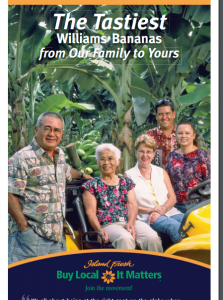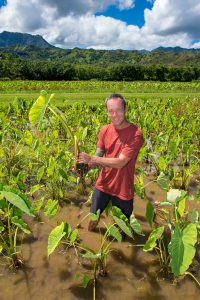Grow local, buy local drives ag department’s goals; New biosecurity plan hearings
Posted on Sep 30, 2016 in MainWhen you live in the middle of the Pacific Ocean, food security takes on a whole new meaning. Currently, about 85 percent of the food we consume locally has to be imported from outside Hawai‘i. The state’s goal is to double local food production by 2020 — transitioning from sugar and pineapple to diversified crops that can meet consumer and energy demands.

BUY LOCAL: The Ha family of Hamakua Springs Country Farms.
To make that happen, Governor Ige and the Hawai‘i Department of Agriculture (HDOA) plan to take action in several areas to help Hawai‘i reach its goals. They include:
- Providing more support for farmers with start-up capital and state long-term leases;
- Buying land in Central O‘ahu, on Kaua‘i and other areas for local production and small family farms;
- Revitalizing dairy, egg and livestock production on O‘ahu and the neighbor islands;
- Encouraging a new generation of farmers through an Agricultural Business Incubator;
- Coordinating statewide water-related policies;
- Ramping up the “Buy Local” campaign and farm-to-school program.
“The average age of farmers statewide is around 60, which isn’t far from the national norm,” said Scott Enright, HDOA director. “So who will be the next generation of farmers? Most of them are going to need land and capital. That’s why we’ve been working with the Agribusiness Development Corporation and the Legislature to acquire thousands of acres on O‘ahu going into production now.”
Enright said the state needs to be more strategic in tracking what is being imported and what is being grown. “We can effect change in local fresh fruits, vegetables and livestock products —the perimeter of a grocery store,” said Enright. “But we’re not going to be competitive in processed food and canned goods. Those will always be imported. It’s more of a commodity-by-commodity view. People say they’d support buying local products, but only up to a certain price point. We’re competing with other countries and states like California. Our food metrics project will show what we’re importing and price points for what crops to grow.”
Enright said the farm-to-table, buy local movement is part of a nationwide trend, spurred by high-profile chefs and an appreciation of fresh, homegrown produce. “We just need more Ed Kenneys, Alan Wongs and Roy Yamaguchis,” he added. He said the challenge is to balance land use to meet the housing shortage with acreage that could be farmed to meet our food security needs.
Enright said HDOA has just 240 employees on a tight budget to oversee everything from quality assurance to monitoring pesticide use to guarding against invasive species. As for the state’s agriculture outlook, he remains optimistic. “
As for the state’s agriculture outlook, he remains optimistic. “HDOA employees do amazing work on behalf of agriculture in Hawai‘i,” he said. “With strong support from Gov. Ige, we’ll be able to accomplish much more.”
Hearings set for new biosecurity plan
Little red fire ants. Zika and dengue. Rapid ‘ohi‘a death. If it seems we in the islands are being assaulted year-round by biological threats large and small, that’s because we are. To combat these threats, the state’s first Hawai‘i Interagency Biosecurity Plan has been developed to provide a comprehensive approach to the problem.
Public meetings on the plan will be held this month to share details of how government agencies and community partners plan to coordinate efforts, improve policies, and identify the staffing and resources needed. “Our threat of invasive species is global,” said Governor Ige. “This biosecurity plan spells out the roles of our partnerships statewide.” The plan includes pre-border policies to prevent invasive species from coming to Hawai‘i; border policies to support inspection of incoming items; and post-border policies to control invasives once they’re here.
“States are seeing invasive species they’ve never had before — some of it due to climate change,” said Department of Agriculture director Scott Enright. “We’re not unique in having invasive species; we are unique sitting at the crossroads of East and West, where species come from all over. That’s why we need to work together to take action.” The public hearing schedule includes:
- Tuesday, Oct. 4, 6 – 8 p.m.,McKinley High cafeteria, Honolulu
- Wednesday, Oct. 5, 6 – 8 p.m.,Wilcox Elementary cafeteria, Līhuʻe
- Thursday, Oct. 6, 6 – 8 p.m., Pomaikai Elementary cafeteria, Kahului
- Saturday, Oct. 8, 9 -11 a.m.,Kaunakakai Elementary cafeteria, Moloka‘i
- Wednesday, Oct. 12, 6 – 8 p.m., Hilo High cafeteria, Hilo
- Thursday, Oct. 13, 6 –8 p.m., Kealakehe High cafeteria, Kailua-Kona
- Saturday, Oct. 15, 9 – 11 a.m., Lana‘i High & Elementary cafeteria
The plan can be downloaded at https://hdoa.hawaii.gov/.

